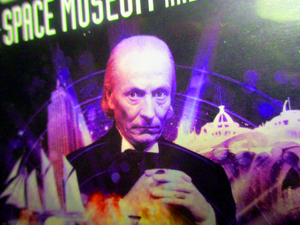The Space Museum
“Four separate journeys. Four choices, that led all the time, closer to here” – Barbara
The initial premise of this story seems quite intriguing—the TARDIS crew skips a ‘time track’ and end up arriving ahead of themselves—and there are some neat ideas explored within this framework: being in a different dimension of time itself, they are spectral and immaterial; they cannot hear the sounds of others nor can they be heard them; they see a version of their future but, as time starts to catch up with them, they feel a strange rushing sensation until they kind of snap into a place before that future happens. It doesn’t entirely make sense (though I try to reason through it below*) but it impressed me as a child. In fact, in my memory from childhood, this was plot of the entire story. In reality, all that part happens in just the first episode. The rest of the story is simply the group avoiding being captured, aiding a rebel slave group, and generally trying to “break the chain of events that led up to” their vision of them being encased in the museum display.
It is this last element that is perhaps the more interesting part of this story. (The actual plot elements are rather lackluster, especially because the ruling Moroks are portrayed rather weakly.) Since the crew are trying to avoid a fate they have already seen, this leads to a lot of interesting discussion as to if and how they can figure out whether their actions are taking them away from that result or inevitably leading toward it. (“Which is the way into those cases? Staying here, going back or still trying to find our way out?”) They have a number of arguments about it but, as Ian points out, “choice is only possible when you know all the facts.” In the end, it seems that things will happen as they saw anyway, but it is the Doctor who realizes that they may have unknowingly spurred events in a different direction despite themselves. (“In the short time we’ve been on this planet, we’ve met people, spoken to them and who knows, we might have even influenced them.” “You mean we don’t necessarily have to change our own future? It could be changed for us?”)
The Doctor gets to shine quite a bit in this story, especially in the interrogation scene as he makes a mockery of the Morok governor and his thought machine. Once the Doctor learns what it is, it is child’s play for him to put whatever images he likes on the screen despite the governor’s insistence that the machine shows unconscious thought and should only show the truth. The Doctor’s constant lateral thinking is highlighted. (“Doctor, why do you always show the greatest interest in the least important things?” “The least important things sometimes, my dear boy, lead to the greatest discoveries.”) We also see our first indication that the Doctor is more physically able to handle things than the average human as he withstands the second phase of processing that should have killed him. He even gets to name drop yet again (James Watt in this case) and by this point it’s clear that this will be one of those endearing traits of the Doctor that will last.
[*So what is the explanation of the ‘time jump’? In a way, it’s actually causality that is off track for the group not two versions of the time. When they begin walking through the planet they leave no footprints. These appear much later—seemingly of their own accord but actually just because the cause and effect relationship is off-kilter. The effects of their footsteps are appearing well after their cause. (We know that there is not simply a ‘real time’ version of the crew making them since the Moroks are there witnessing it.) This must also mean that in the spaces where they were earlier that their voices are suddenly being heard aloud and the machine that they tried hitting and swiping at must be suddenly shuddering and clanging from the blows. This distortion also puts them behind causality on the other end—they see effect of themselves being imprisoned well before getting to the events that cause that. Soon time and causality catch up with them from both sides such that they are exactly at the right rate—their yet-unreached future disappears and there already finished past shows itself. However, just that glimpse of seeing the future affects their actions enough to change it—all the events lead up to the same point but there is something slightly different, presumably that Vicki puts just a little extra effort and inspiration into inciting the revolt that eventually frees them.]
Best unsettling moment:
Though the portrayal of the Moroks and Xerons is not particularly compelling, seeing young and hopeful Sita suddenly and unexpectedly shot down just as he celebrates the start of their revolution is heartbreaking, especially Vicki’s reaction to it.
Firsts:
- The Doctor’s first museum in space (“I always thought I’d find one someday.”) so I guess is where he starts famously ‘keeping score’!
- First appearance of a museum-piece Dalek
Regrets:
I wish the sci-fi idea of the effects of time jump could have been fleshed out better and over a longer time within the story. And also that the Moroks were more menacing rather than moronic so that their parts of the story had a little bit more weight. And then there are those ridiculously distracting Xeron eyebrows….

